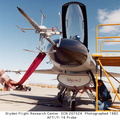
WIKIARCHIVES.SPACE
The Human Spaceflight Archive

This close-up view shows the AFTI F-16 air probe early in the research program. It consists of a nose boom resembling a long pipe, and four indicators that look and act like weather vanes. The indicators on the left and right measure pitch, or the movement of the airplane's nose up or down. Those on the top and bottom of the boom measure yaw, or movement of the nose to the left or right.
Information
- Taken in
- Edwards Air Force Base
- Author
- NASA
- Description
-
This close-up view shows the AFTI F-16 air probe early in the research program. It consists of a nose boom resembling a long pipe, and four indicators that look and act like weather vanes. The indicators on the left and right measure pitch, or the movement of the airplane's nose up or down. Those on the top and bottom of the boom measure yaw, or movement of the nose to the left or right.
Similar probes are standard on most research and prototype aircraft. The data from the indicators is recorded aboard the aircraft and/or radioed to the ground. This data includes both the amount of yaw and pitch at any given time, and the rate at which both motions changed in flight. This information, subsequently processed and compared to wind tunnel results, may reveal stability and aerodynamic abnormalities.
The two metal half-circles and their attachment fixtures are not part of the air probe. Rather, they are used to calibrate the indicators on the ground, enabling the data to be corrected for instrument errors. The figure in the photograph is shown holding a red "Remove Before Flight" ribbon, a reminder to the ground crew that it must be taken off prior to a research mission.
- Created on
- Thursday 28 October 1982
- Albums
- US SPACE PROGRAM / AERONAUTICS RESEARCH / F-16 / F-16AFTI
- Source link
- An early (1983) photograph of the AFTI F-16 team, commemorating the aircraft's 50th flight. It shows the initial configuration and paint finish of the AFTI F-16, as well as the forward mounted canards and the spin chute.
- Visits
- 12
- Rating score
- no rate
- Rate this photo
- License
- Public Domain
- Modified by WikiArchives
- No (original)
- Downloads
- 0
Powered by Piwigo
